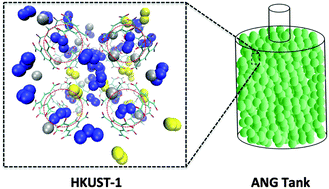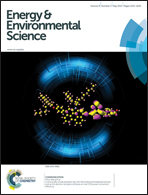A thermodynamic tank model for studying the effect of higher hydrocarbons on natural gas storage in metal–organic frameworks†
Abstract
Metal–organic frameworks (MOFs) are promising materials for storing natural gas in vehicular applications. Evaluation of these materials has focused on adsorption of pure methane, although commercial natural gas also contains small amounts of higher hydrocarbons such as ethane and propane, which adsorb more strongly than methane. There is, thus, a possibility that these higher hydrocarbons will accumulate in the MOF after multiple operating (adsorption/desorption) cycles, and reduce the storage capacity. To study the net effect of ethane and propane on the performance of an adsorbed natural gas (ANG) tank, we developed a mathematical model based on thermodynamics and mass balance equations that describes the state of the tank at any instant. The required inputs are the pure-component isotherms, and mixture adsorption data are calculated using the Ideal Adsorbed Solution Theory (IAST). We focused on how the “deliverable energy” provided by the ANG tank to the engine changed over 200 operating cycles for a sample of 120 MOF structures. We found that, with any MOF, the ANG tank performance monotonically declines during early operating cycles until a “cyclic steady state” is reached. We determined that the best materials when the fuel is 100% methane are not necessarily the best when the fuel includes ethane and propane. Among the materials tested, some top MOFs are MOF-143 > NU-800 > IRMOF-14 > IRMOF-20 > MIL-100 > NU-125 > IRMOF-1 > NU-111. MOF-143 is predicted to deliver 5.43 MJ L−1 of tank to the engine once the cyclic steady state is reached. The model also provided insights that can assist in future work to discover more promising adsorbent materials for natural gas storage.



 Please wait while we load your content...
Please wait while we load your content...